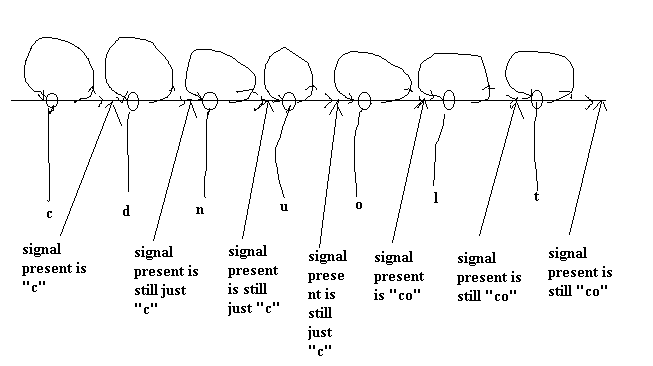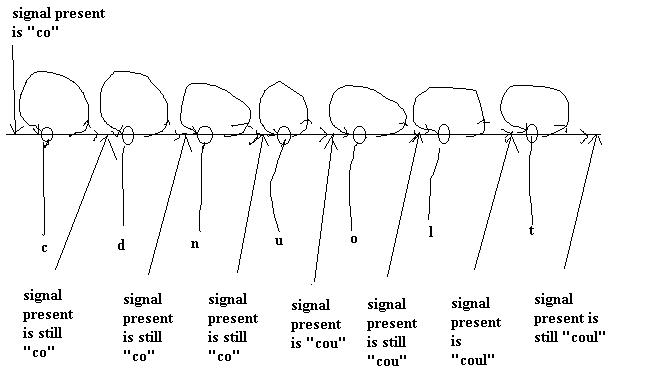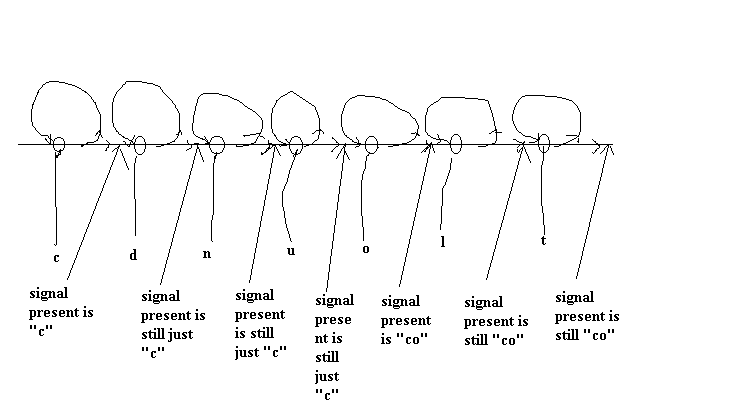Re: Typoglyecmia
[Martin Taylor 2005.10.30.23.48]
[From Rick Marken (2005.10.26.1600)]
Fred Nickols (2005.10.26.1655 EDT)] -
My wife sent me the following. My immediate reaction is
that there’s got to
be a really nifty PCT explanation for this phenomenon…
I cdnuolt blveiee taht I cluod aulaclty uesdnatnrd waht I was
rdanieg…
This is lovely, Fred. One thing I notice about this is that I can read
it
because I am mapping the visual perceptions into auditory imaginings.
So as
I read the line above I am saying to myself “I couldn’t believe
that…”
It’s slower going that when I read a normal sentence but the random
letter
sentence made be realize that I am doing the same thing –
mapping visual
perceptions into auditory imaginings – when I read a normal
sentence. So
that’s at least the start of a
model.
I don’t have a PCT model as such, but a process description
(proposal) is in the book “Psychology of Reading” by Ina and
me (Academic Press, 1983). The apparent facts (as of the research I
knew in 1983) are that different facets of the words are used at
different times in the reading process. The original quoted statement
is a little too specific: “… it deosn’t mttaer in waht oredr
the ltteers in a wrod are, the olny iprmoatnt tihng is taht the frist
and lsat ltteer be in the rghit pclae. The rset can be a taotl mses
and you can sitll raed it wouthit a porbelm. Tihs is bcuseae the huamn
mnid deos not raed ervey lteter by istlef, but the wrod as a
wlohe”
Speed readers would have less trouble with this passage than
would normal readers, because it is only after some 80 msec that the
positions of the middle letters has any effect on the word’s
interpretation. Let’s consider the word “horse”. After
perhaps 20-30 msec, the outer contour has an effect, and “kcnas”
is more or less equivalent to “horse” but by 160 msec, the
outer shape doesn’t matter at all. If the first and last letters are
correct (“hcnae”) recognition is better after about 50 msec
or so. So far, the order of the middle letters has not yet had any
appreciable effect. Between about 50 and 80 msec is the time scale in
which the quoted statement is more or less correct. That’s a reading
speed of 12 - 20 words per second, 720 - 1200 wpm, which is fast, but
not impossibly so. Between 80 and 160 msec, letter order does come
into play, but it’s probably used more to check on an interpretation
already developed than to generate an interpretation by analysis. Only
after 160 msec does the phonetic representation of the word seem to
matter.
Take into account that these are group averages, based on
literate university students. Individuals presumably woudl behave
quite differently. I don’t know of experiments to support this
directly, but indirect evidence (as of 1983) suggests that some people
might not interpret much until they begin to perceive the letter
order, whereas othe people (fast as well as speed readers) would
usually be onto the next word (or rather, word group) before the
letter order is ever perceived. Only word-by-word slow readers woudl
normally use fully the letter order and woudl be confused by non-words
such as “woudl”.
The basic process proposal is that the perception happens from
the outside-in, that perception happens in levels (not a novel idea to
PCT; I think in its modern form it goes back to the 1830’s – the name
F. C. Donders springs to mind), that if a reasonably probable
interepretation/perception at a low level enables a reasonably
probable one at a higher level, no analysis or checking is done at the
lower level, but if that doesn’t happen, analysis (meaning at this
level the letter order) can have time to occur and may help to permit
a reasonably p[robable interpretation at the higher level. The same
kind of interplay between rapid multi-possibility parallel perceptions
and slower analytic checking or synthesis was assumed to happen at all
levels of perception. We called it the “Bilateral Cooperative
Model”, as there seemed to be a hemispheric preference, the
parallel process happening in both hemispheres but preferentially in
the right, the analytic process primarily in the left
hemisphere.
Whether either the experimental results have been sustained or
disputed in the last 20 years, or whether the process proposal has
been refuted by later data is not known to me. But as of 1983, it did
seem to support a levels-based view of the perceptual process, at
least for words.
It may also interest you to know that it is quite possible to
read material that has almost no letters, as in this example from the
book:
![]()
Martin







